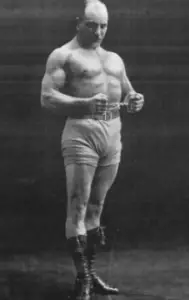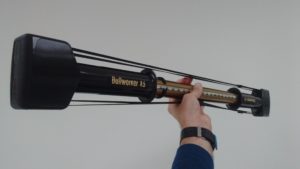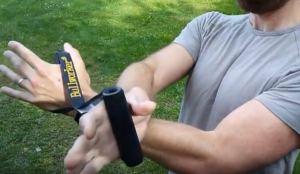I’m a huge fan of isometrics and have trained in this fashion for several years.
For those unfamiliar with this training concept, it involves pushing or pulling against an immovable object. For instance, imagine standing facing a wall and trying to push the wall away from you for several seconds (like a vertical bench press). Assuming the wall is well made, there won’t be any movement but your pectoral and tricep muscles will get an amazing workout. This type of training is called overcoming isometrics.
This is not a new form of training and has been around since the 1920s when scientists tied down one leg of a frog and found that it grew stronger as it strained against its bonds.
This form of training is highly effective:
- It’s quick. Each “set” or isometric contraction lasts only 10-15 seconds.
- It’s safe. The muscles are largely static so you are not moving under load, which can be a cause of muscle sprains and tears.
- It’s focused. The high tension involved means you can easily feel the target muscle being worked. This helps to develop the mind-muscle connection.
- It works. The famous strongman, Alexander Zass used this form of training as his principle method of developing his legendary strength.

Alezander Zass using a training device that looks very similar to a modern day Iso-Bow.
I’ve trained using an original Bullworker X5 pictured below, which I purchased in the 1980’s.

It’s a simple device that still works perfectly. It consists of a metal tube that contains a long spring. By pushing the two handles, at each end of the tube, together, the spring is compressed.
Two straps connect the handles and pulling them apart also forces the handles together, again compressing the spring.
This arrangement enables a great number of exercises to be performed. For each exercise involving an isometric contraction, once the spring has been compressed to its maximum extent, it is held there for up to 10-15 seconds.
I wrote an article on the Bullworker which can be seen here. To my amazement, I was then contacted by John Hughes at Bullworker who suggested I tried out their Iso-Bow. I was further surprised when they sent me one in the post. I decided to write a review on the Iso-Bow.
Here’s me opening it:
The Iso-Bow comes with a leaflet that details a number of isometric holds that the device can be used for. It also features a number of assisted stretching exercises that can incorporate the Iso-bow.
This is a real plus point as I believe that a comprehensive stretching routine should form part of any muscle development program. I find that the muscles being developed can become tight over time. I think this is where the term “muscle bound” stems from. Unless they’re stretched out, you risk becoming less flexible and you could end up pulling or tearing your muscle.
The Iso-Bow itself is well made and consists of a thick nylon strap that feeds through two rigid plastic handles, which have a smooth foam surface. The strap is stitched together at the midpoint so that it looks something like a figure eight. It looks like very good quality stitching and I think it would be impossible to break the device using my own physical strength.
The device is comfortable to use, and even when applying maximum tension, I never felt the handles dig into my hands.
Here’s a video of me actually using the device:
My preferred exercises:
Cross Chest Squeeze
 The arms are crossed in front of the body so that the hands are pushing outwards whilst trying to pull the Iso-bow apart.
The arms are crossed in front of the body so that the hands are pushing outwards whilst trying to pull the Iso-bow apart.
This causes a peak contraction in the pectoral muscle ie all the fibers in the muscle are at their maximally contracted point during this exercise.
The arms can be repeatedly raised and lowered to put emphasis on different areas of the chest muscle.
The Archer Squeeze

This is a back exercise. Hold the Iso-Bow as though it was a bow and arrow (hence the name).
Try to pull the Iso-bow apart using the back muscles (not your arm muscles). Visualizing your entire shoulder girdle moving backwards can help to achieve this.
Ab Crunch

Bend over and position the Iso-bow so that the handles are on each side of your lower thigh. Pull your stomach in and use your abs to curl your upper torso towards your knee.
Keep your arms straight to fully resist this movement and to create the isometric ab exercise.
You should really feel this one.
Lateral Pull

Bend forward and roll your shoulders forward.
With straight arms, try to tear the Iso-Bow apart.
You should feel this in your traps and lateral deltoids.
I went on to repeat these exercises a further two times, so that I did three sets in total. I held each isometric contraction for 10-15 seconds. I try and hold each contraction using maximum strength.
There are dozens of exercises you can do with the Iso-bow and I’m sure I’ve only just scratched the surface.
Even after such a relatively short workout, my muscles were on fire by the end. I love the feeling of tone that my muscles had after going through this program.
I particularly like how portable this device is and it weighs only a few grams. I’m sure this will be thrown into my luggage whenever I’m travelling.
Conclusion
The Iso-Bow is a simple yet highly effective piece of kit.
Anyone interested in isometric training (or anyone looking to get stronger) should own one.
It’s well made and will easily outlast me. It’s also very light and highly portable.
When I looked, I was also pleasantly surprised by the price (see here on Amazon).
The Iso-bow complements my Bullworker X5: using a closer hand position opens up additional exercises which are difficult to perform on the Bullworker.
I understand that there’s a smaller version of the Bullworker called a Steel Bow and it would be interesting to see how I could incorporate this into my workout routine – watch this space!
